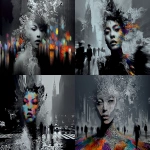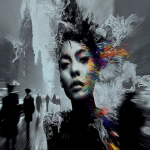Explore the Best AI Image Gallery

Quantum Leaps in Creativity: Exploring the Impact of Quantum Computing on Art and Design
The world of art and design is on the cusp of a revolution. While wearable technology has been making waves, ushering in new forms of creative expression, a more profound shift is brewing—one powered by the enigmatic realm of quantum computing. This nascent field holds the promise to unlock unprecedented levels of creativity and innovation, pushing the boundaries of artistic exploration like never before.
Unlocking New Creative Frontiers
Quantum computers harness the principles of quantum mechanics to perform calculations at speeds unimaginable for classical computers. This immense processing power has profound implications for creative fields:
- Generative Art: Quantum algorithms can generate complex and intricate art pieces, exploring abstract patterns and unforeseen visual concepts that transcend human imagination.
- Design Optimization: Architects, product designers, and engineers can leverage quantum simulations to optimize structures, materials, and functionalities, leading to more efficient and aesthetically pleasing creations.
- Personalized Experiences: Quantum computing enables the creation of highly personalized artistic experiences tailored to individual preferences and emotions, blurring the lines between art and interactive storytelling.
Pushing the Boundaries of Design
Beyond generating art and optimizing designs, quantum computing can revolutionize the very act of creation:
- Novel Materials: Quantum simulations can help discover new materials with unique properties, enabling artists to work with previously inconceivable substances.
- Interactive Sculptures: Imagine sculptures that respond to viewers presence and emotions, transforming in real time through quantum-powered algorithms.
- Immersive Environments: Quantum computing can create hyperrealistic virtual worlds and augmented reality experiences, immersing audiences in breathtaking artistic landscapes.
Navigating the Ethical Landscape
As with any powerful technology, quantum computing raises ethical considerations that require careful attention:
- Ownership and Authorship: Who owns the rights to artwork generated by quantum algorithms? How do we define authorship in a world where machines can create?
- Bias and Representation: Quantum algorithms are trained on data, which can reflect existing societal biases. Its crucial to ensure that quantum-powered art and design are inclusive and representative.
- Accessibility and Equity: The benefits of quantum computing should be accessible to all, not just a privileged few. We need to address the potential for widening the gap between those who can harness this technology and those who cannot.
The Quantum Canvas of Tomorrow
The future of art and design is intrinsically linked to the advancements in quantum computing. While challenges remain, the potential rewards are immense. As we navigate this uncharted territory, its essential to foster open dialogue, ethical guidelines, and responsible development to ensure that quantum technology empowers creativity and enriches our world.
](https://images.ai-img.art/thumbnails/150/685ae68cfab93a7e59a71206867b060c45bd6fd3cd561c4fe60fca514b09c5f8.webp)

](https://images.ai-img.art/thumbnails/150/a3ed6513a6661aa3ee46e0c2924d1e8888854e91d8908de39db5590dc41f8d8f.webp)
](https://images.ai-img.art/thumbnails/150/2ebdeb4f7db35100e5be5de9bc3e533a40d14e5feedefd7ffc586524a0f3ba8c.webp)
](https://images.ai-img.art/thumbnails/150/7cf5a08238f29c821f52bb4f63db48af0b7f633ff3b9f7253074d78ced9ff6f6.webp)


















](https://images.ai-img.art/thumbnails/150/ff09e32d2be011c0dd785984c5c1e47839ce551a31da1bde242860b30df2aa30.webp)



](https://images.ai-img.art/thumbnails/150/0ba0be922ab76af53f75ab90126ae2b18a600ee3b96941e8ab897a9f10594e5a.webp)









](https://images.ai-img.art/thumbnails/150/847809c77ca9a73b68bc190e6efb06fec87157685a243730d5a66a403b0e6e10.webp)




](https://images.ai-img.art/thumbnails/150/bd056a4718c27444e064198762f8dc8ffa1f74f1afd7dcda8d5cb8b142797d6e.webp)






